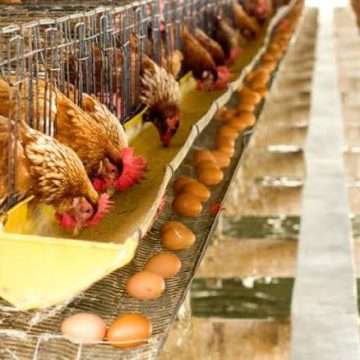How to Make Layers Feeds
Buying chicken feeds vs formulating your feeds has advantages and disadvantages for both sides.
However, what’s most important to poultry farmers is to offer nutritious feeds to your birds, and manage costs at the same time.
In the poultry business, the cost of feeds is the Number 1 cost you incur because most of your expenses are on feeds and drugs.
How to Make Organic Feeds for Laying Chicken?
A nutrient is the chemical or elemental composition of feeds and it is also the end product of digestion that nourishes the body. An example of feedstuff is maize and its vital nutrient content is glucose.
Layer feeds are made of the following nutrients, and adding these resources together is the best way to feed your layers and increase egg production in chickens.
Homemade Chicken Feed Formula for Egg Layers
If you want to formulate your feeds to reduce the cost of buying marsh for your egg-laying layers, you can make use of this formula and the table below.
This is the percentage of each nutrient you need to make any KG of your layers mash.
|
Ingredients |
CP (%) Kg |
GE Kcal oil (%) |
EE (%) |
CF (%) |
LS (%) |
MT (%) |
Ca (%) |
P (%) |
|
Cassava Meal |
2.5 |
0.3 |
3.5 |
0.04 |
0.022 |
0.18 |
0.19 |
|
|
Cassava Peel |
5 |
2423 |
5.8 |
9.5 |
||||
|
Maize |
8.9 |
3432 |
4.00 |
2.0 |
0.25 |
0.18 |
0.01 |
0.09 |
|
Guinea Corn |
11 |
3300 |
3.00 |
2.0 |
0.35 |
0.10 |
0.04 |
0.32 |
|
Wheat Bran |
16 |
1870 |
3.50 |
8.50 |
0.90 |
0.25 |
0.10 |
0.30 |
|
Palm kernel meal |
18 |
2175 |
6.00 |
12.0 |
0.64 |
0.39 |
0.21 |
0.16 |
|
Rice offal |
6.0 |
1319 |
7.6 |
36.6 |
0.16 |
0.06 |
0.17 |
0.49 |
|
Groundnut Cake |
45 |
2540 |
6.00 |
5.00 |
1.60 |
0.48 |
0.20 |
0.20 |
|
Soybean Meal |
40 |
2486 |
1.8 |
5.0 |
2.60 |
0.60 |
0.25 |
0.60 |
|
Soybean Cake |
44 |
2700 |
3.50 |
6.50 |
2.80 |
0.59 |
0.20 |
0.60 |
|
Fish Meal |
65 |
2860 |
4.50 |
1.00 |
4.60 |
0.80 |
6.10 |
3.00 |
|
Blood Meal |
80 |
3080 |
1.0 |
1.0 |
6.9 |
1.01 |
0.28 |
0 |
|
Cottonseed Meal |
25 |
7.8 |
25.10 |
0.54 |
1.3 |
0.15 |
0.90 |
|
|
Beniseed |
25 |
5820 |
49.1 |
6.3 |
3.5 |
3.8 |
1.06 |
0.47 |
|
Bone Meal |
37 |
15 |
||||||
|
Oyster Shell |
3.7 |
35 |
||||||
|
Raw Rock Phosphate |
33.6 |
13.0 |
||||||
|
Limestone |
CP – Crude protein
GE – Gross energy
EE – Ether extract
CF – Crude fiber
LS – Linseed
MT – Methionine
Ca – Calcium
P – Phosphorus
How Many KGs does a Layer eat per day/Month?
To further understand the KG of layers mash to prepare for X number of birds, here’s a simple analysis based on direct experience in the poultry business.
With commercial feeds, you should assume feed consumption of 130 grams per bird per day, and your layers should eat 2 to 3 times per day.
For birds that lay brown eggs, feed consumption for 100 birds will be 130×100 = 1300 grams = 30kg per day.
This means slightly over one bag of feed every two days. To buy a week’s supply, multiply 13×7 = 91kg, this is slightly less than four bags of feed per 100 birds per week.
As a rule, you should assume that one bag of feed would feed about 190 layers per day.
For a well-managed flock, 190 birds should produce on average, 133 to 142 eggs (70-75% egg production) per day throughout the year. This works out to about 4.4 to 4.7 crates.
Thus, a bag of feed should produce at least four crates of eggs.
With good feed and management, the production of 5 crates of eggs per 25kg of feed is possible.
Feed consumption of layers is almost constant throughout the laying year.
The following recommended feed for layers per day is given as a guide.
- 100 grams from the start of lay to 4 weeks into lay (20-24 weeks)
- 115 grams (25-28 weeks)
- 130 grams (29-36 weeks)
- 140 grams (36 weeks to end lay)
Conclusion
If you’re raising 200 layers and above, it’s advisable to get your tools for feed production and source the feed ingredients locally.
With a grain cruncher and pellet maker machine, you can begin to produce cheap homemade chicken feeds for egg layers, broilers, and others.
However, if you do not have these machines yet, you can formulate your feed by getting the ingredients and taking them to Miller to produce your feeds for your poultry.








